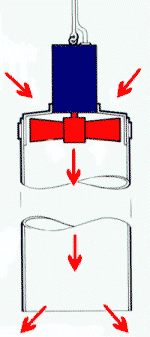
| ||||
W. Tombling Ltd.
Wembley House
Dozens Bank
West Pinchbeck
Spalding
Lincolnshire
PE11 3ND
U.K.


The problem of stratification in buildings
When air is heated it rises, this is why in buildings with high ceilings, it feels cold at floor level and hot in the roof space. The effect is called stratification, and causes the following problems:
Increased heating bills because -
a) The heating system must work harder to maintain the desired temperature at floor level.
b) Heat loss through the roof increases.
Condensation - As air cools, its capacity to store moisture is reduced, and the excess moisture is released as condensation. Cardboard cases and similar moisture absorbing products stored at low level absorb it, resulting in damage.
Destratification with axial fans
Destratification uses axial fans in the roof space to direct the hot air back to floor level. However axial fans on their own are inefficient, because the hot air spreads out and rises again. The higher the ceiling, the less effect destratification fans have.
Plastic ducting and axial fans for destratification
The efficiency of destratification fans is greatly improved by adding plastic ducting:Improved efficiency - Plastic ducting directs all of the air to floor level. As the roof height increases the effect becomes more pronounced.
Hot air is directed where its needed - Plastic ducting can deliver hot air to specific locations, such as workstations, production lines etc.
Difficult buildings can be destratified - Plastic ducting returns hot air to floor level in buildings where natural air flow is restricted i.e. those with high racking, restricted roof spaces etc.
Energy savings with destratification
Energy savings are determined as follows:Saving in annual heating cost (%) = (ceiling height (ft.) - thermostat height (ft.)) x 0.5
Example
A warehouse with a ceiling height of 25ft. and a thermostat set at 68F and mounted at 5ft.
The annual saving in heating costs will be (25 - 5) x 0.5 = 10%
The following table summarizes the energy savings expected with destratification fans and plastic ducting. Note the savings increase as the thermostat setting is reduced. The savings are given as a percentage of the total annual heating costs.
Thermostat Setting |
Savings per 10 feet of ceiling height above the thermostat level |
68° |
5% |
60° |
6% |
50° |
7% |
Determining the size of destratification fan required
The destratification fan should be selected so that the total air volume of the building passes through it 4 times per hour i.e.Destratification fan size (CFM) = (building volume (cubic feet) x 4)/60
Example
A building measuring (W)40ft. x (L)40ft. x (H)20ft. will require destratification fans as follows:
Building volume = 40 x 40 x 25 = 40500 cubic feet
Fan Size = (40,500 x 4)/60 = 2700 CFM
Rather than using one 2700CFM axial fan, better results will be achieved using several smaller fans spread around the roof space.
Plastic ducting should be chosen to match the fan diameter as closely as possible. Where an exact match is not possible use the next size of plastic ducting.
Activair plastic ducting
Activair plastic ducting is available in 10 diameters to suit most fans. Its low cost and flexibility make it ideal for destratification. Installing destratification fans and plastic ducting in buildings with high ceilings can lead to savings of upto 30% per annum in heating bills with payback in less than 12 months.For more information or a quotation for Activair plastic ducting see:
The benefits of Activair air ducts
Sizes and quotations for Activair layflat ducting
Destratification using ceiling fans
See also ceiling fansIf you found this page useful, please take a moment
to tell a friend or colleague about it.
Copyright © 2003/6, W. Tombling Ltd.